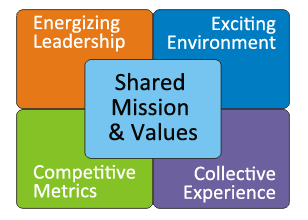Culture is a consequence of past behaviour and a predictor of capabilities for future achievements. Corporate culture has been defined as learned behaviour patterns which are characteristics of the members of the company and which are not a result of biological inheritance.
Companies with a culture that is better aligned with business goals and innovation strategies outperform their competitors. Indeed, an adequate cultural alignment is more important than addition investments in R&D, as proven by the fact that the big R&D spenders out there are not necessarily the best innovator companies at the global scale.
Corporate culture is a product of the company’s leadership and its ability to energize employees and managers with the corporate vision and its mission. Culture is an expression of collective values and experience. Culture is fashioned by corporate action and communications. Culture is a consequence of corporate metrics and competitive realities.

It is the corporate leadership who drive and is responsible for the culture of a company, and it is there, in the leadership that innovation-related issues appear: leaders who are too satisfied with current results and do not insist on proper innovation to maintain competitive progress; leaders who think that innovation is the job of specialists and “R&D takes care of it”; leaders who think short-term only and are afraid to risk; leaders who talk but do not act and do not provide the right example of innovation drive and accountability; leaders who do not ensure that innovation is a good track for recognition and promotion.
Culture correlates with the lifecycle of the company: in startup companies a culture of innovation is driven by entrepreneurs inspiring with their vision and dedication; in companies growing fast it is nourished by strongly committed managers. As companies mature and become more concerned by efficiency, market share, asset management and risk containment, more and more aspects of the culture are impacted by administrative rules and procedures; while companies challenged by declining performance have too often a culture affected by leadership sclerosis, worries about cost margins rather than innovation, risk avoidance and vacillating moves towards exit or rejuvenation.
Culture is difficult to evaluate because it necessitates clear frameworks for measuring it and the measurements have to be done en masse across most ranks in the company probing subjective perceptions. This takes time and is quite costly. Most studies show that executives have rosier perspectives of innovation, while people deeper in the organization are often more critical. Interestingly, our studies show that companies who limit innovation decisions only to executive levels fare worse on average than those that have stronger involvement of bottom-up decisions.
A company with a culture characterized by energizing vision, respect and trust, intense collaboration, focus, recognition of true performers; i.e. culture oriented towards market results and support for competitive initiative ensures a fertile environment for successful innovation and great competitive performance. On the other hand, a company with a culture of inward looking silos, of excessive control and compliance, of mistrust and punishment for daring to risk is assured of a descent into obsolescence and decline.
Aligning culture to business goals and innovation strategies requires leadership that shows determination to compete, that is fully involved and has the knowledge and the patience to succeed. A central element in the development of culture is the corporate innovation system that needs to be comprehensive, competitive, methodical and people-oriented.
A corporate culture conducive to sustained and effective innovation is easy to destroy but slow to develop. Development of an effective culture of innovation requires addressing both the internal aspects like (a) ideation (openness, risk taking, learning), (b) implementation (project structure, failure acceptance and training), (c) exploitation (market connectivity, customer empathy, and training); as well as external aspects concerning (d) partners (openness and conflict handling), (e) customers (empathy, searching both for new solutions and for new classes of customers) and other 3rd parties (media savviness, lobbying, and satisfying investors).